Are you struggling with marketing operations, planning, or executing strategies and campaigns? I hear you.
Many marketing operations managers are bogged down by campaign management, lead gen, and marketing analysis tasks despite using many tools that promise to help. The good news is that it doesn’t have to be this way.
In this article, I’ll introduce you to 8 marketing workflow software solutions that really deliver. Whether you’re struggling with content planning, approval processes, collaboration, or data analysis, these tools will help you supercharge your team’s productivity.
Contents
What is marketing operations management?
Marketing operations management involves planning, executing, and optimizing marketing activities within an organization. It focuses on the coordination between people, internal processes, and technology that enhance the effectiveness of marketing strategies to achieve better ROI.
What is marketing operations software?
Marketing operations software is a category of platforms developed to streamline and improve marketing management processes. Typically cloud-based, these types of software come with different features, such as campaign planning, content management, marketing automation, and collaboration tools.
What are the benefits of marketing operations management software?
Marketing operations management software offers important benefits to marketing teams, enhancing campaign management and collaboration. Here are five key advantages:
- Improved campaign visibility: The first advantage is the centralized view of your campaigns. This comes in handy when you want to keep tabs on all your ongoing marketing efforts from a single dashboard and make more informed decisions throughout the campaign lifecycle.
- Centralized asset management: Many marketing operations solutions offer a centralized repository for all media assets. This feature makes it easy for you to organize, access, and share resources like images, videos, and documents.
- Efficient content distribution: Marketing operations tools can help with content distribution. They allow you to easily push out content across multiple social media channels directly from the platform. They can support in-advance scheduling, handle multiple media types, and ensure that no content goes live without the proper quality checks.
- History tracking: This is the “version history” for your marketing projects. It tells you who made what changes and when so you can track a project’s progress or revert to a previous version if something goes off track.
- Real-time in-context feedback: Collaboration features within the marketing operations software allow for immediate feedback directly within the content. The benefit? Less back-and-forth communication and faster content approvals.
What are the key features to look for in marketing operations software?
When you’re searching for marketing operations tools, there’s no shortage of features to consider. But there are some must-haves. Here’s what I’m looking for:
- Collaboration: This feature lets you invite all your marketing team members to join the creative process. You should be able to adjust between different permission levels to accommodate complex workflows that involve internal and external team members or clients.
- Approval: Approval tools help ensure your content gets the green light from the right folks without delays or confusion.
- Content Calendar: Here’s my favorite — a content calendar that visually displays your marketing schedule. It’s crucial to help you keep your marketing efforts coordinated.
- Project management: With project management features, you can plan and organize all your marketing projects and brand assets in one place.
- Marketing automation: This feature helps you streamline repetitive tasks like email marketing, lead nurturing, or social media posting, saving you (a lot of) time and effort.
- Analytics and reporting: This feature helps you optimize your marketing processes for better results. Good analytics software will make data reports easy and straightforward.
The best 8 marketing operations software tools
Marketing managers tackle a lot of tasks, including content planning, project management, and more. That’s why they need marketing tools to make these tasks smoother. Below are the best 8 tools to consider:
1. Planable: best marketing operations software with collaboration and approval features
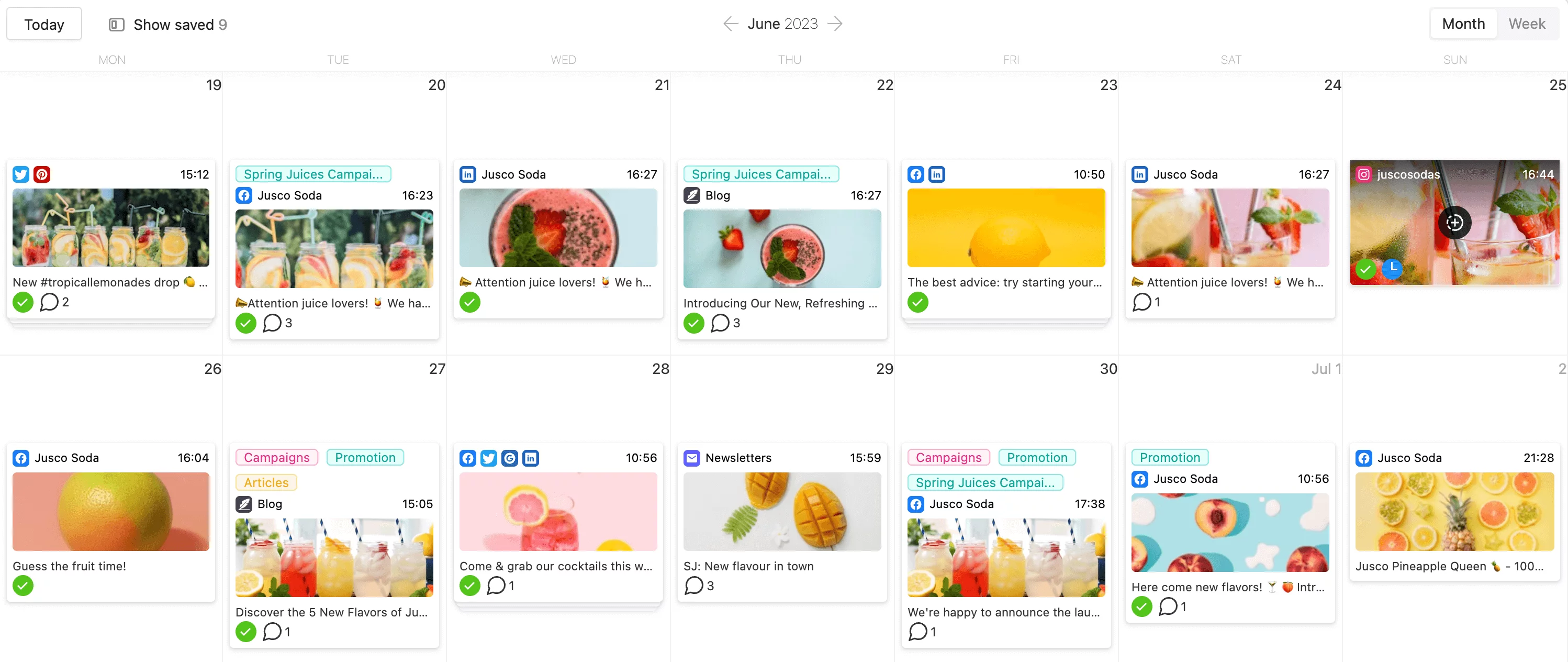
Marketing content planning calendar in Planable
Planable is a content collaboration and social media scheduling platform. Social media teams, freelancers, and digital agencies use Planable to plan, create, approve, and schedule any type of written content — from social posts to blog posts and emails to newsletters.
Key features
Content calendar
Planable offers a social media content calendar that lets you plan and schedule content across all your favorite platforms (Instagram, TikTok, YouTube, Google My Business, LinkedIn, Facebook, Twitter, and Pinterest), including long-form content posts like blogs, newsletters, and briefs.
But, there’s more. Imagine you have a post that you want to share multiple times based on a schedule that suits you best — be it daily, weekly, or monthly. With Planable’s Recurring Post feature, you can do that in a few clicks. No hassle of manually reposting.
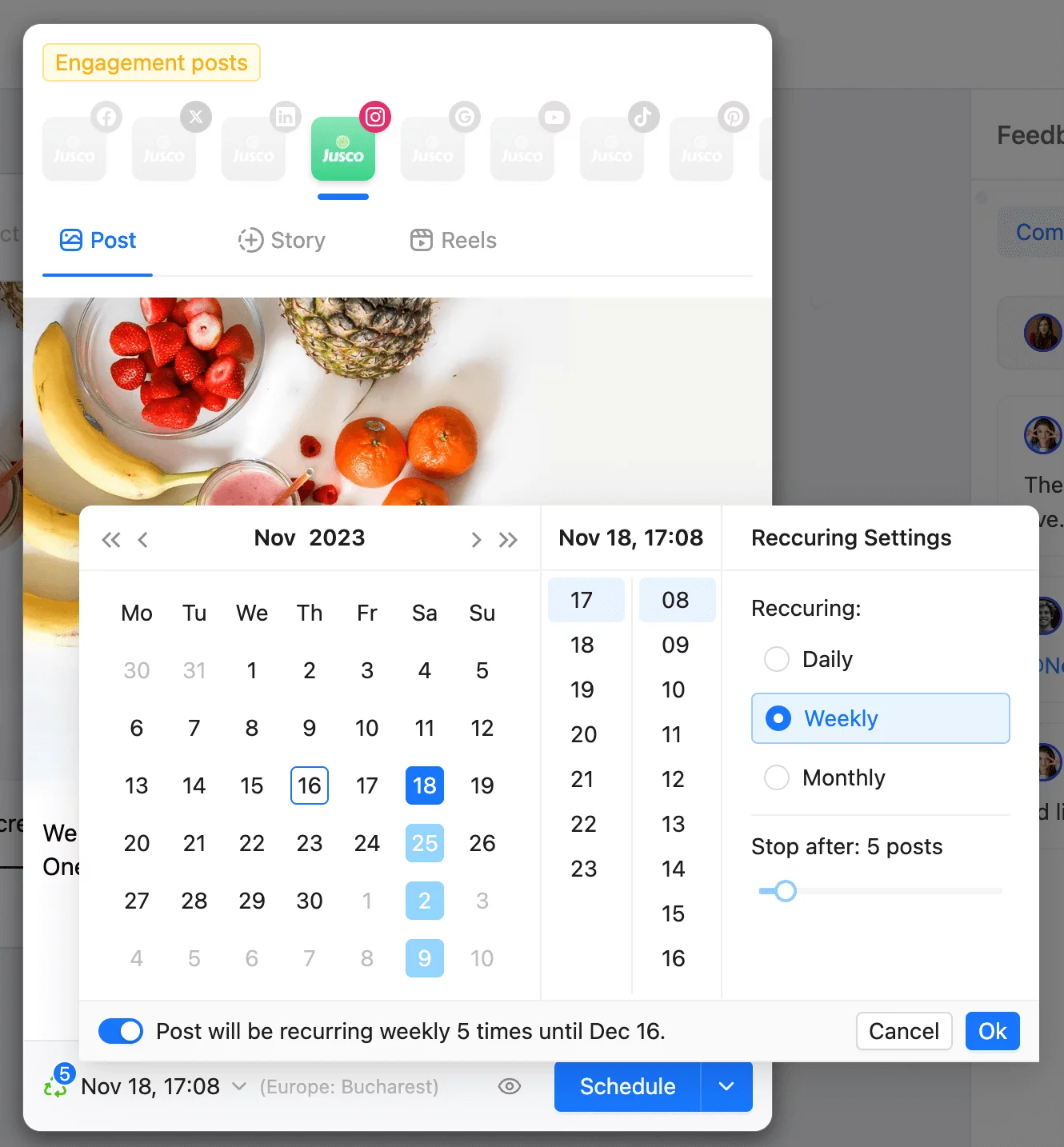
Setting recurring posting times in Planable
Team collaboration
Planable is the platform where your whole team can come together, brainstorm ideas, and fine-tune content drafts, making your content ready for publishing.
Another thing I like about Planable is that you can leave comments and share suggestions directly within the content.
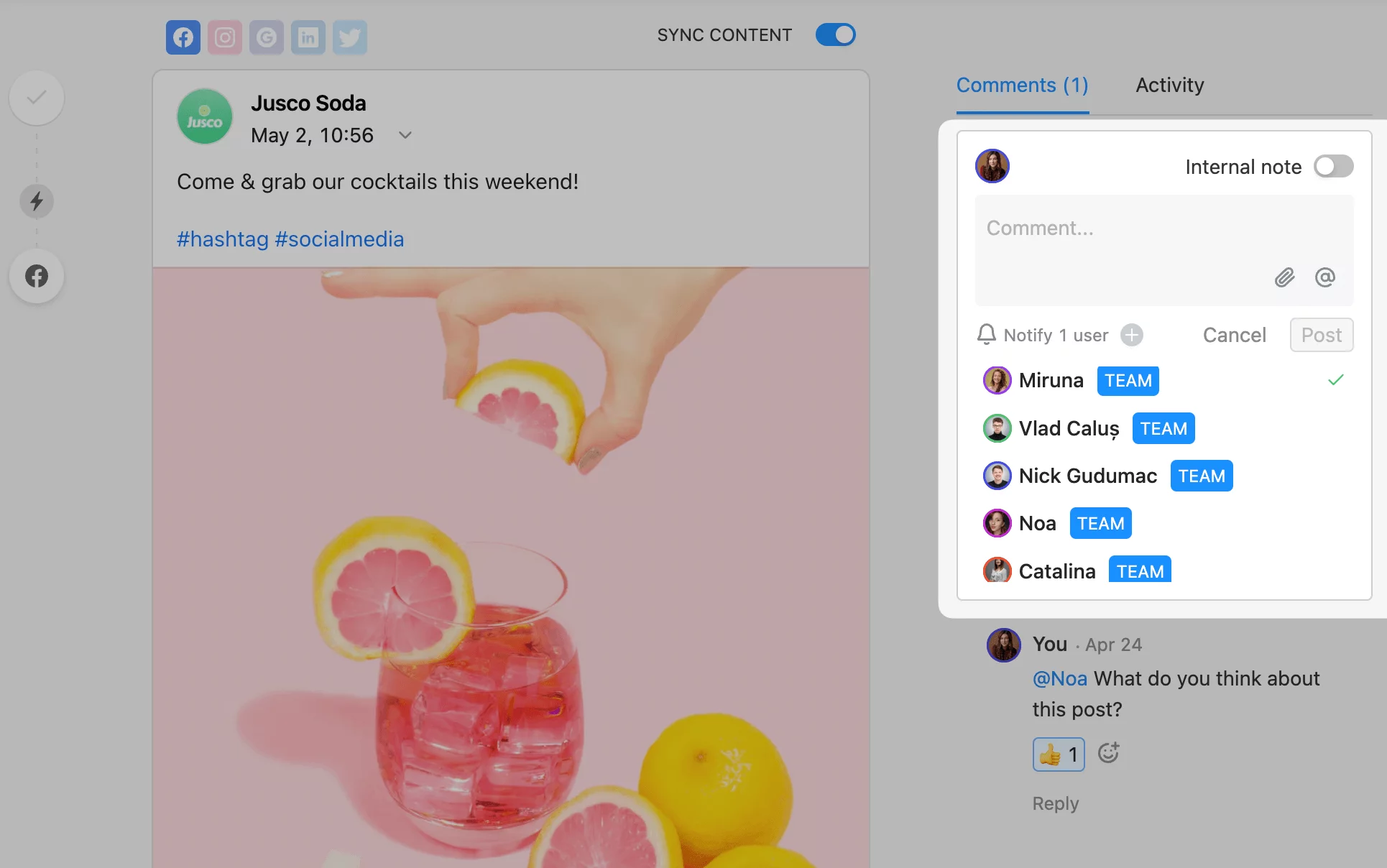
Content collaboration in Planable
Approval workflows
Planable makes it easy to get the green light on your content before it goes public. It offers you multiple approval levels, which is particularly handy for situations where several individuals need to review and approve your content.
So, whether you’re dealing with complex social media approval processes or other scenarios requiring multiple checks, Planable can help.
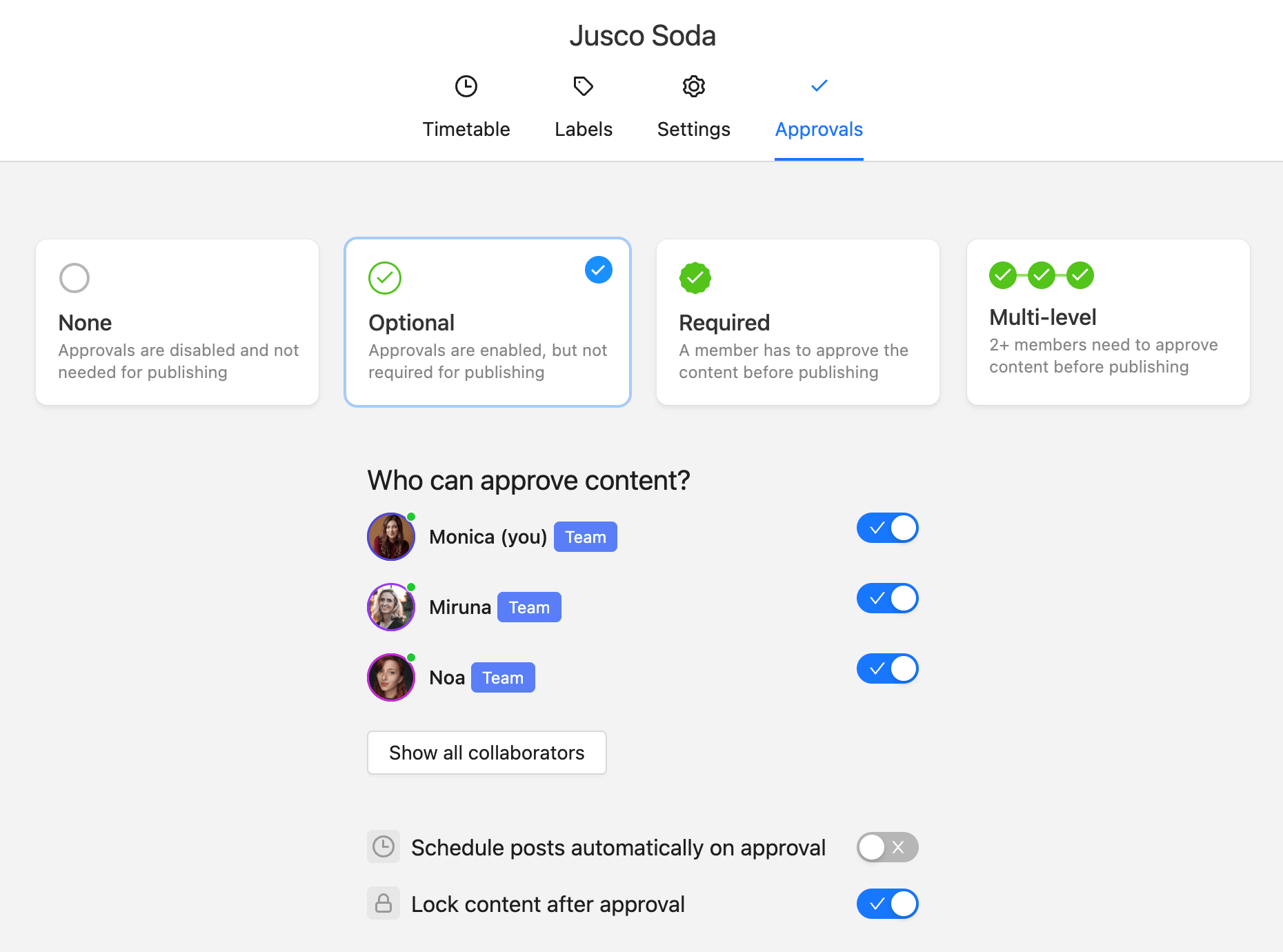
Approval levels in Planable
Activity history
This feature lets you see who did what and when. It provides a clear view of the content development process, making it easier to track changes, approve edits, and revert to previous versions when needed.
Pricing
With Planable’s free plan, you can create up to 50 total posts. When you’re ready to upgrade, Planable’s paid plans start at just $11/user when paid annually.
Drawback
While Planable offers a super-intuitive tool for social media analytics and reporting, it lacks social monitoring and listening.
Takeaway
Planable is best suited for social media teams and content creators looking for a streamlined platform to efficiently plan, collaborate on, and schedule content across multiple social platforms you manage.
2. Zapier: best for simplifying work processes with automated app integrations

Zapier is an automation platform designed to connect and streamline workflows between various web applications. It operates on the principle of Zaps — automated workflows triggered by specific events in one app that result in actions in another app.
Key features
- Filtering and conditional logic: Apply filters and conditional logic to your Zaps. For example, you can set up a Zap to create Trello cards based on new events in Microsoft Outlook.
- Zap templates: Zapier has a collection of Zap templates for common tasks and integrations. Those templates simplify the setup process for you.
- Integration with over 6,600 apps: Zapier has a library of integrations with popular web applications. It pretty much works well with almost any application you can think of.
Pricing
Zapier’s free plan is limited to 5 single-step Zaps. To benefit from unlimited Zaps, you’ll have to pay $71.29/month.
Drawbacks
- Complexity for advanced workflows: Creating very complex or highly conditional workflows can be time-consuming for less experienced users.
- Free plan constraints: Zapier’s free plan is great for starters. But if you’re looking to handle a lot of actions, the price tag on its paid plans might pinch your pocket.
Takeaway
If you’re a marketing professional wanting to optimize your marketing workflows, use Zapier to automate routine processes and enhance productivity in your marketing operations.
3. Trello: best for visual project management
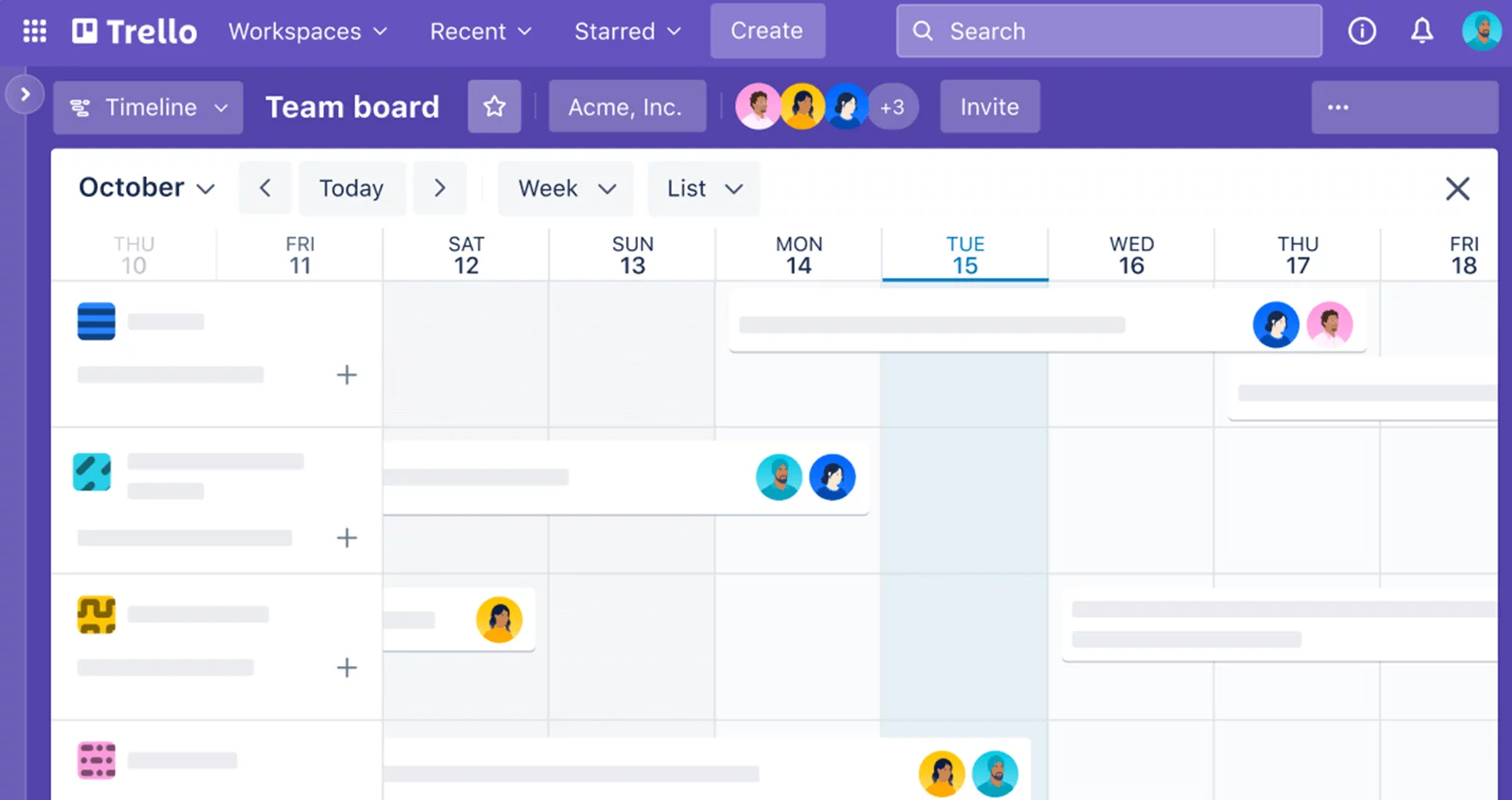
Trello is an online project management tool that allows teams to manage, collaborate, and assign tasks.
What I like about Trello is that it’s highly flexible and can be adapted to many use cases.
Key features
- Views: Choose from board, timeline, table, calendar, dashboard, map, or workspace views to see your projects from every angle. I love the table view, especially for managing large projects that span multiple teams.
- Power-ups: Add extra features and integrate your favorite third-party apps right into your Trello workflow. If you need to report your exact working hours, the Clockify Integration for Trello helps you track time without the hassle of extra browser extensions. You can start and stop timers directly from my Trello cards.
- Templates: Trello offers ready-made templates for many use cases like project management, productivity, marketing, remote work, and more.
Pricing
You can use Trello for free for unlimited boards. Its paid plans start from $6/user/month, which comes with checklists and custom fields.
Drawbacks
- No task dependencies: You can’t easily show that Task B can’t start until Task A is done. You’d need to use workarounds or Power-Ups to track dependencies, and it can be a bit complicated.
- Team member addition challenge: Removing someone from all your boards is simple, but adding a new member to all your boards at once isn’t as straightforward as it should be.
Takeaway
Trello is a great tool for marketing teams seeking a visually engaging platform for project management and planning.
4. Zoho Analytics: best for data-centric marketing teams requiring advanced data analytics capabilities
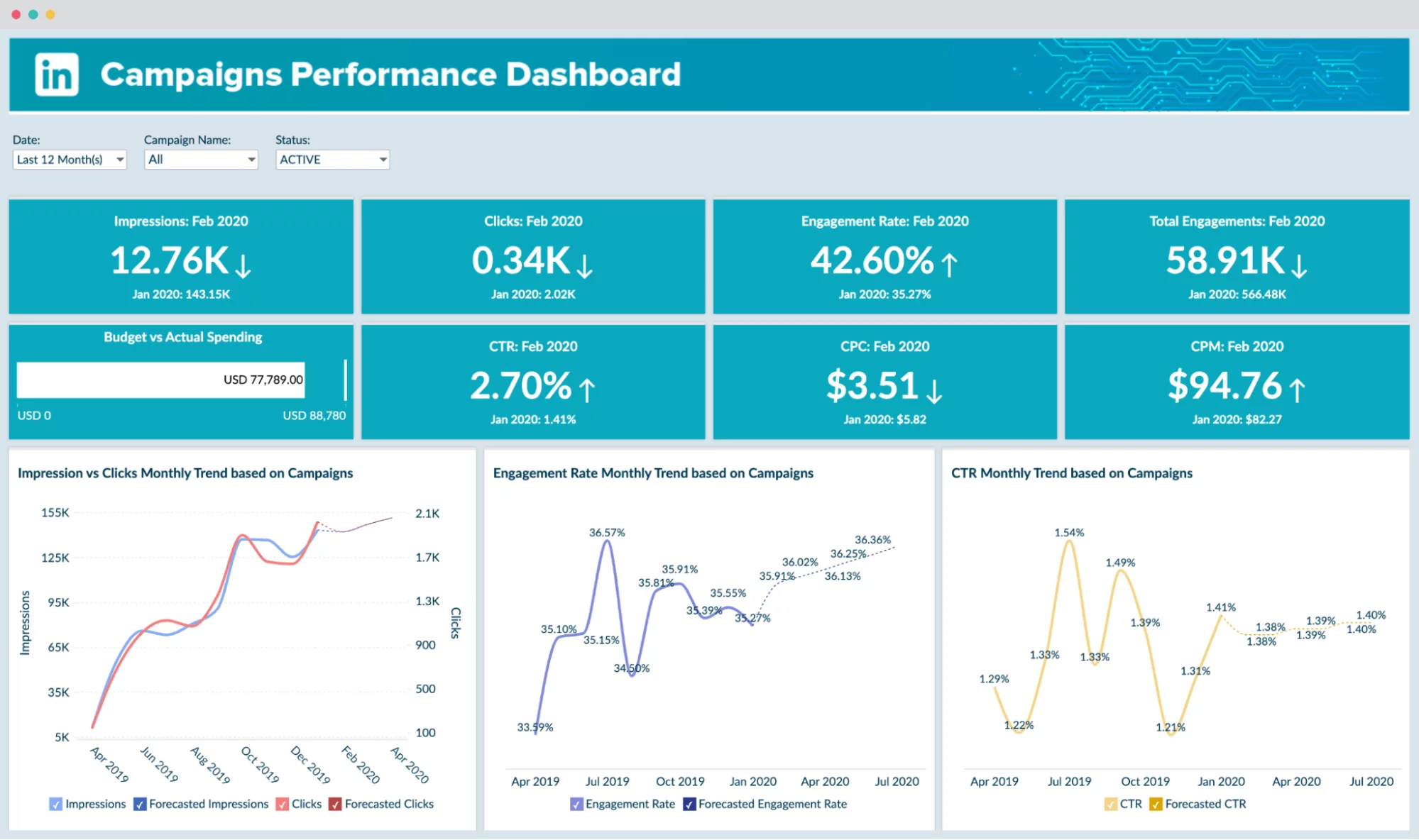
Zoho Analytics is a business intelligence and data analytics platform to extract data, create insightful dashboards, and make data-driven decisions.
What makes Zoho Analytics a good marketing operations software is its ability to integrate marketing data from various sources. It allows you to enhance campaign management and optimize marketing strategies.
Key features
- Visual analysis: Use various chart types, widgets, and pivot tables to build informative reports. Also, use interactive features, like drill-downs and contextual filters, for exploratory analysis.
- Data preparation and management: Zoho has a self-service data preparation tool to cleanse your raw data for a more effective analysis. It can even help you get rid of duplicates or wrong entries with smart suggestions.
- Augmented analytics: Zoho lets you enhance your customer data analysis with its machine learning (ML) and natural language processing (NLP) capabilities to get key insights from your data.
Pricing
You can use Zoho Analytics for free on your local server (on-premise) for one user. Or, you can opt for paid and cloud-based plans starting at €30/user/month plus usage fees.
Drawbacks
- Learning curve: Zoho Analytics, like other complex business tools, can be tricky to learn. Your marketing team might need some training to use it effectively.
- Low performance with large datasets: Working with lots of data can slow things down. I personally think streamlining data integration would improve user experience.
Takeaway
Try Zoho Analytics if you’re a data-driven marketing professional looking for a robust marketing operations tool to make solid campaign decisions.
5. Slack: best for real-time team communication and collaboration
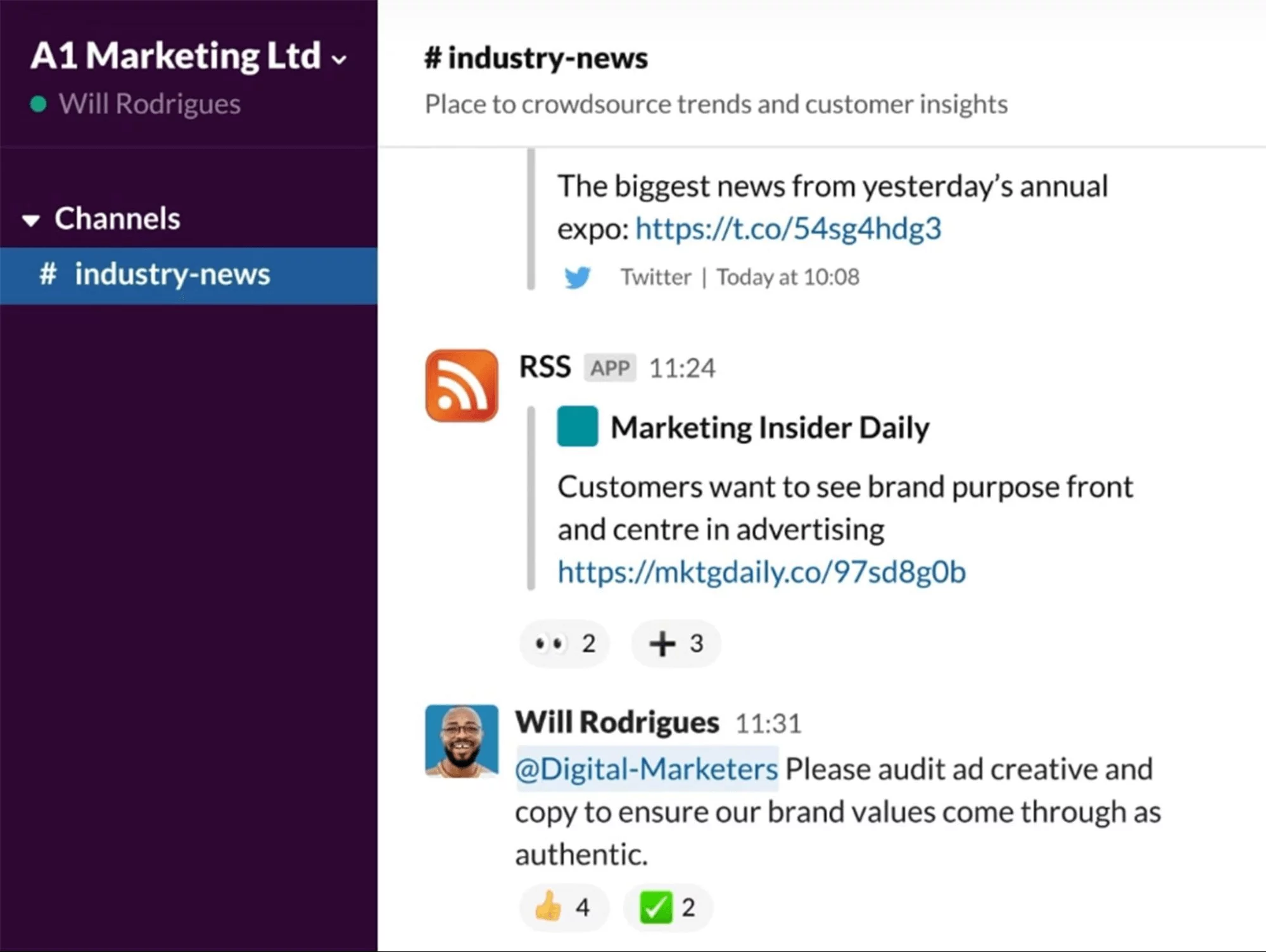
Slack is a popular collaboration platform that facilitates real-time communication and document sharing among teams through channels and messages.
I’ve tried several Slack alternatives in the past, but Slack always stood out for me. I particularly like its user-friendliness and smooth communication features.
Key features
- Recurring reminders: Keep your team on track with recurring reminders. This feature is a lifesaver for those regular tasks that need a nudge every now and then.
- Advanced search modifiers: You can use quotes to find exact matches or add an asterisk to search for all instances. This makes it easy to find important Slack documents.
- Integrations: Connect your favorite tools with Slack. For example, you can manage calendars or collaborate on files without switching between different apps.
Pricing
Slack’s free plan is a great starting point for small teams or individuals wanting to improve their communication at no cost. Its paid plans start from $6.75/month for unlimited app integrations.
Drawbacks
- Overwhelming notifications: Managing notifications in multiple Slack channels and chats can be tough. I’ve experienced it, and it can lead to too much information at once.
- Messages can become unorganized: Important Slack messages can get buried in a long conversation thread. You’ll perhaps have difficulty finding and referencing specific content when needed.
Takeaway
If you’re after a communication platform with features like instant messaging, file sharing, and team collaboration in one place, Slack is the solution.
6. Zendesk: best for multichannel support
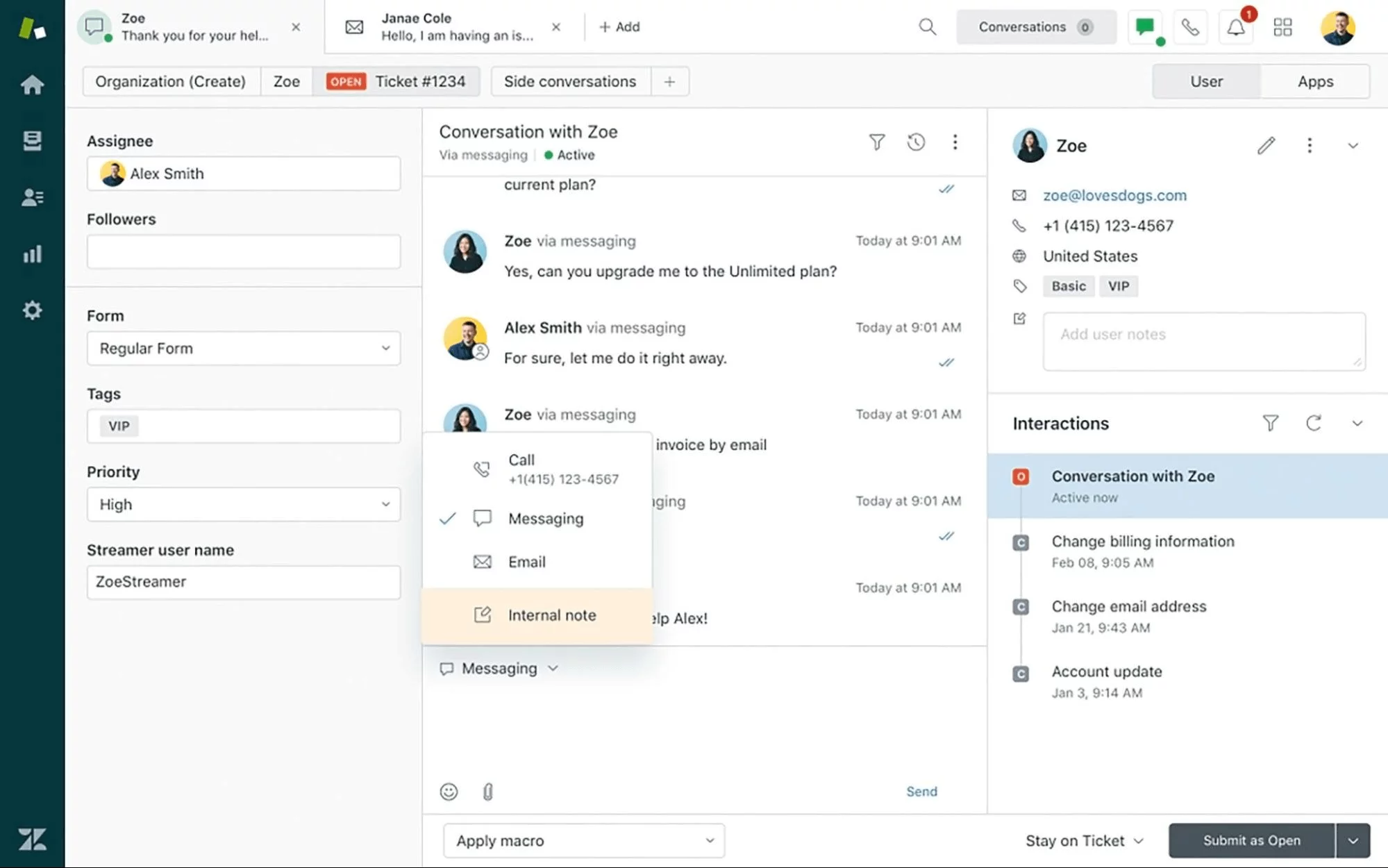
Zendesk is a customer service and engagement platform. It offers many features designed to help companies interact with their potential customers, resolve issues, and provide better support.
Key features
- Knowledge base: You can create and maintain a knowledge base. It’s a self-service portal where customers can find answers to common questions and issues.
- Ticketing system: Zendesk provides a centralized system for managing customer support requests, known as tickets. Tickets can be created via email, chat, web forms, and other channels.
- Mobile accessibility: Zendesk offers a mobile app that enables support agents to manage tickets and interact with customers on the go.
Pricing
Zendesk offers a 14-day free trial. The cheapest Zendesk plan is €69/agent/month, and it includes a ticketing system and ready-to-use analytics dashboards.
Drawbacks
- Cost: Zendesk can be expensive, especially for small businesses. The pricing structure can become prohibitive as your team and support needs grow.
- Complex setup: The initial setup and customizations can be complex, requiring a steeper learning curve.
Takeaway
Zendesk is more suitable for businesses aiming to improve their customer support operations, particularly those that focus on improving helpdesk efficiency, multichannel support, and customer satisfaction. With Zendesk’s pros and cons, the platform is more suitable for businesses aiming to improve their customer support operations, particularly those that focus on improving helpdesk efficiency, multichannel support, and customer satisfaction.
7. Hubspot: best for managing customer relationships and automating marketing tasks
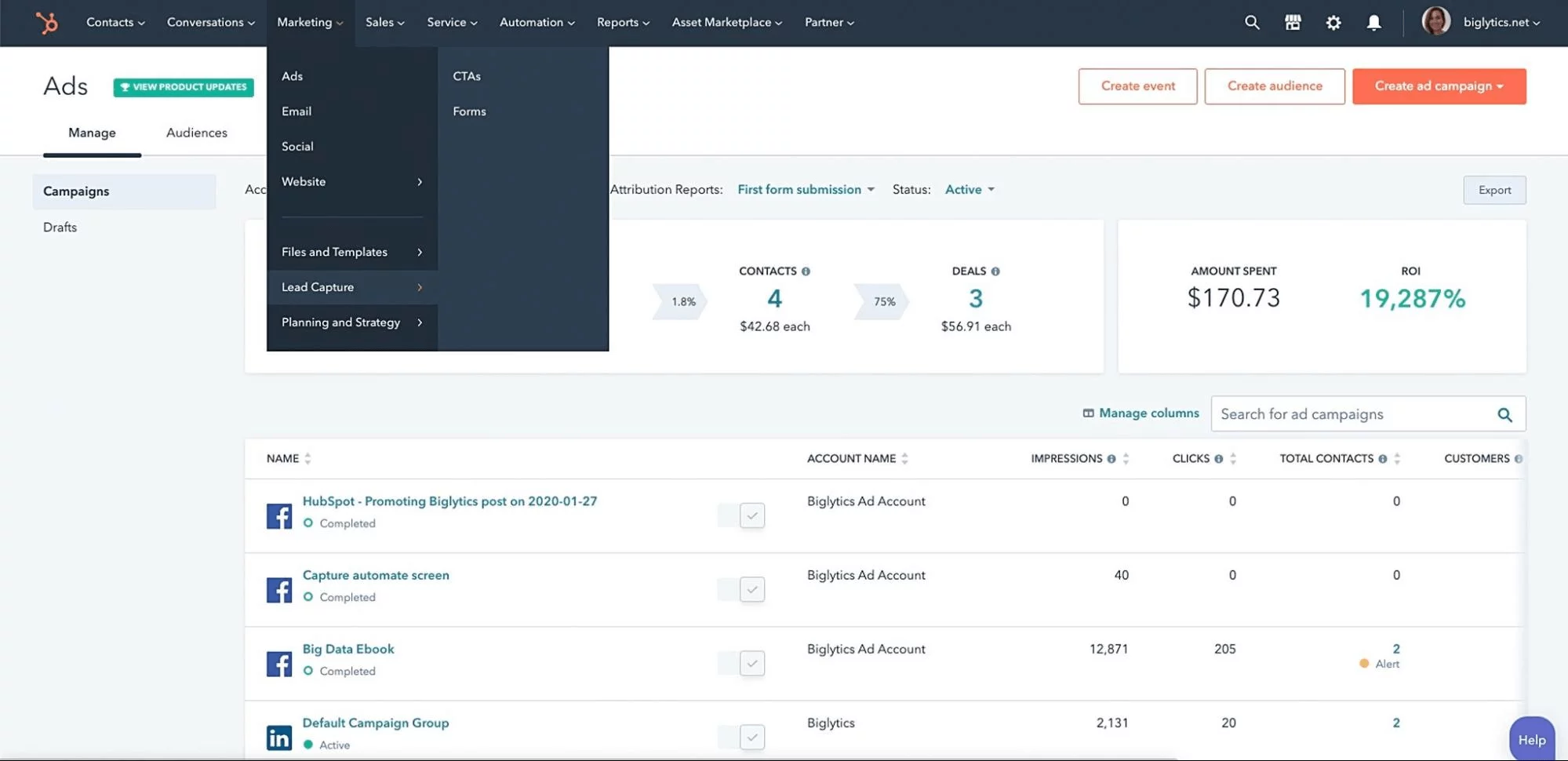
HubSpot is a leading customer relationship management (CRM) solution that provides tools to help businesses attract and engage their customers.
I’d say HubSpot has been the number one operations software for many marketing leaders for years because of its extensive toolset. However, this adds complexity, which might end-up defeating the initial purpose of managing marketing processes easier.
Key features
- Marketing automation: Create and automate marketing campaigns, including email marketing, lead nurturing, and social media scheduling.
- Website development and hosting: HubSpot allows you to create and host your website with a simple drag-and-drop editor, all in one place. There’s no need to search for separate hosting — it’s all under one roof.
- Sales and marketing dashboards: HubSpot dashboards give you a full view of your business’s performance. This includes website traffic, email engagement, lead conversions, and sales.
Pricing
HubSpot’s Marketing Hub has a low-cost option at €20/month for 1,000 contacts. Other plans can get pricey, starting at €880/month for 5,000 contacts.
Drawbacks
- Complexity: HubSpot can be complex, especially for users who are new to a CRM system or marketing automation platform.
- Contacts-based pricing: HubSpot’s pricing is based on the number of contacts in your database. This can make it costly as your contact list grows.
Takeaway
HubSpot is most suitable for marketing teams seeking an all-in-one platform to automate their marketing, sales, and customer service efforts for comprehensive growth.
8. Drift: best for automated chat interactions and streamlined customer support
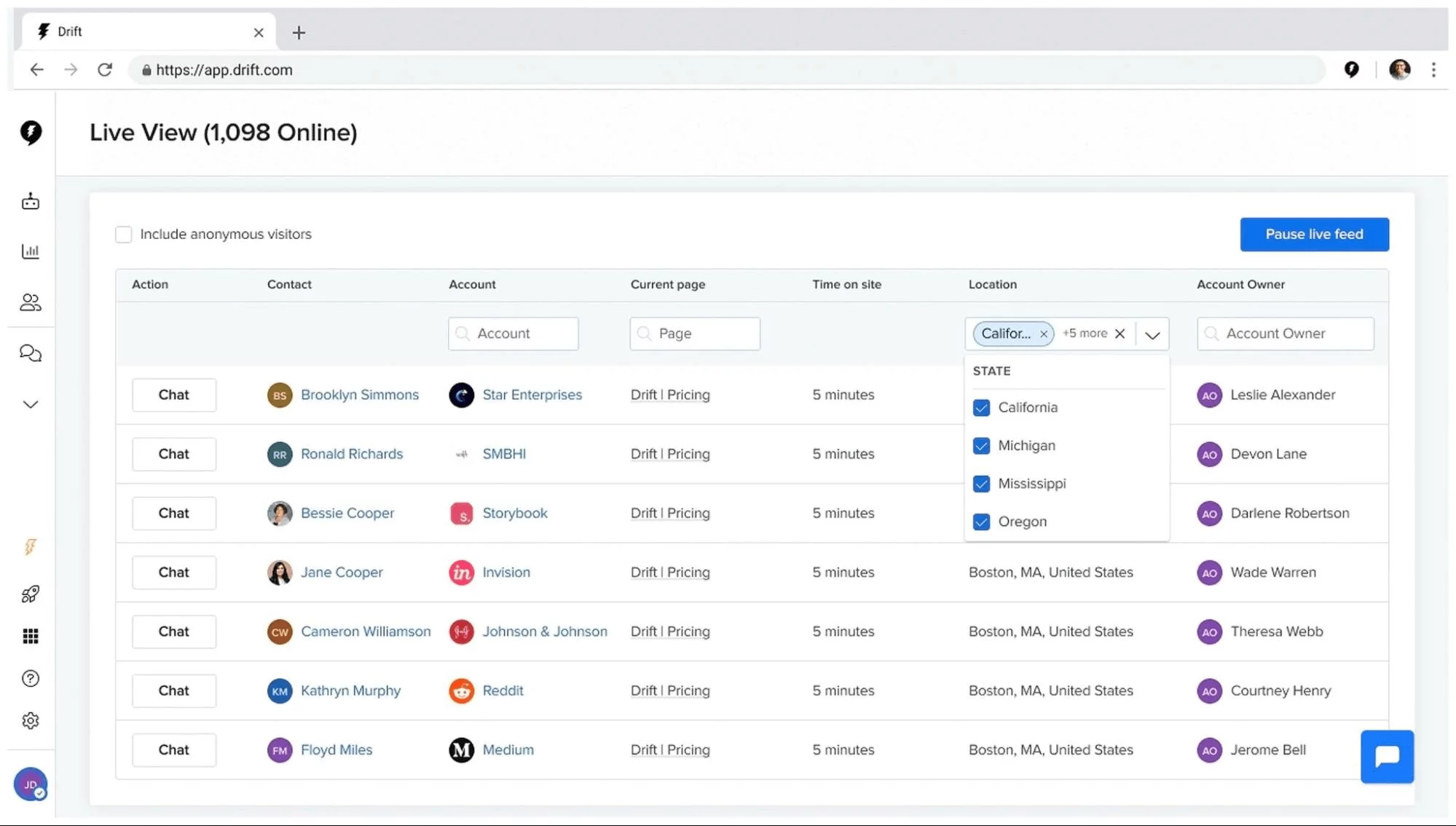
Drift is a messaging and marketing software focused on conversational marketing and sales. Companies use Drift to engage with their website visitors through live chat and custom chatbots to improve customer interactions.
Key features
- Live chat: Drift offers a handy live chat widget that lets your website visitors connect with your business in real-time.
- Email management: Drift’s email management software helps you find and update contacts in your target accounts. It syncs with your CRM and marketing tools to keep your contact info up-to-date.
- Analytics and reporting: Drift helps you see which conversational strategies on certain web pages bring in your top leads. It also shows you where most of your sales and revenue come from.
Pricing
Drift’s pricing starts at $2,500/month, which might be a hefty investment for smaller businesses.
Drawbacks
- Cost: Drift is quite pricey, starting at a hefty $2,500/month when billed annually.
- Overwhelming for visitors: A live chat on a website might bother some visitors and make their experience not so great.
Takeaway
If you’re looking to enhance customer engagement and marketing efforts through real-time conversations and chatbot automation, Drift is a good solution for you.
Marketing operations FAQs
How do marketing and operations work together?
Marketing and operations work together by aligning their efforts and exchanging key information. Operations provide the necessary infrastructure and processes to support new products and marketing campaigns. Marketing is responsible for demand generation, market data, and feedback that operations can use to optimize processes.
What is the difference between marketing operations and marketing management?
Marketing operations focus on the execution and coordination of marketing activities and campaigns. On the other hand, marketing management involves the strategic planning, decision-making, and leadership of marketing initiatives.
Why do you need marketing operations?
Without marketing operations, you’ll struggle with fragmented and inconsistent marketing activities. This will lead to wasted resources and difficulties in measuring the impact of your marketing efforts.
What software should an operations manager know?
If you’re an operations manager, sign up for Planable. It’s a great tool for content planning, collaboration, and approvals. For advanced data analysis and reporting, you may find Zoho Analytics to be a helpful tool in making data-driven marketing decisions. You can also use Trello for visual project management and Zendesk for multi-channel client support.




